Human Body Homeostasis: Nervous and Endocrine Systems Compared
VerifiedAdded on 2023/06/11
|11
|2212
|181
Report
AI Summary
This report provides a comprehensive overview of the nervous and endocrine systems and their roles in maintaining homeostasis within the human body. It begins by detailing the structure and function of the nervous system, including the different types of neurons and the process of nerve conduction. The report then defines hormones and outlines the structure and function of the endocrine system, providing examples of hormones and their mechanisms of action. Finally, it compares and contrasts the endocrine and nervous systems in maintaining homeostasis, using specific examples of positive and negative feedback mechanisms. The report references various books, journals, and online resources to support its explanations and findings.

Task 2
Paraphrase This Document
Need a fresh take? Get an instant paraphrase of this document with our AI Paraphraser
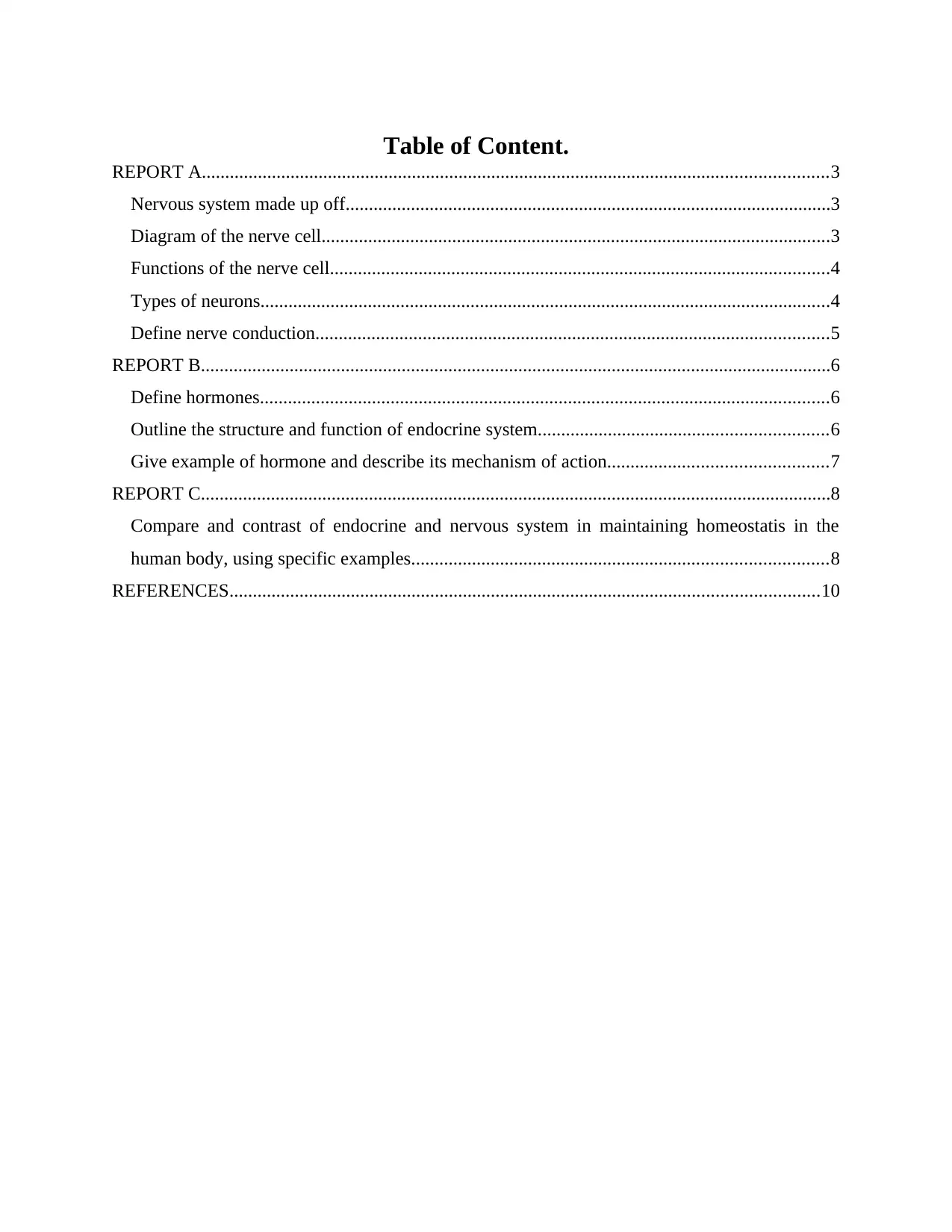
Table of Content.
REPORT A......................................................................................................................................3
Nervous system made up off........................................................................................................3
Diagram of the nerve cell.............................................................................................................3
Functions of the nerve cell...........................................................................................................4
Types of neurons..........................................................................................................................4
Define nerve conduction..............................................................................................................5
REPORT B.......................................................................................................................................6
Define hormones..........................................................................................................................6
Outline the structure and function of endocrine system..............................................................6
Give example of hormone and describe its mechanism of action...............................................7
REPORT C.......................................................................................................................................8
Compare and contrast of endocrine and nervous system in maintaining homeostatis in the
human body, using specific examples.........................................................................................8
REFERENCES..............................................................................................................................10
REPORT A......................................................................................................................................3
Nervous system made up off........................................................................................................3
Diagram of the nerve cell.............................................................................................................3
Functions of the nerve cell...........................................................................................................4
Types of neurons..........................................................................................................................4
Define nerve conduction..............................................................................................................5
REPORT B.......................................................................................................................................6
Define hormones..........................................................................................................................6
Outline the structure and function of endocrine system..............................................................6
Give example of hormone and describe its mechanism of action...............................................7
REPORT C.......................................................................................................................................8
Compare and contrast of endocrine and nervous system in maintaining homeostatis in the
human body, using specific examples.........................................................................................8
REFERENCES..............................................................................................................................10
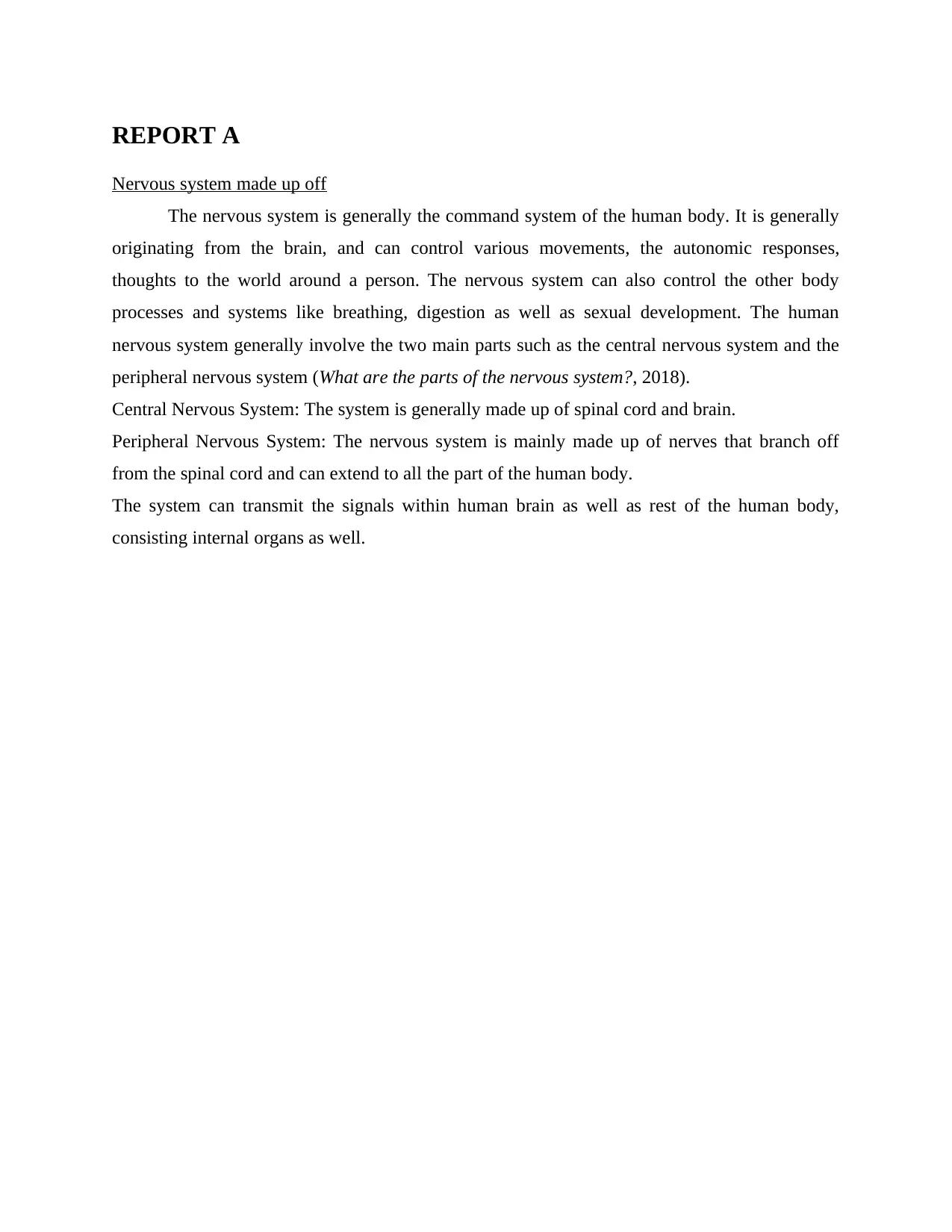
REPORT A
Nervous system made up off
The nervous system is generally the command system of the human body. It is generally
originating from the brain, and can control various movements, the autonomic responses,
thoughts to the world around a person. The nervous system can also control the other body
processes and systems like breathing, digestion as well as sexual development. The human
nervous system generally involve the two main parts such as the central nervous system and the
peripheral nervous system (What are the parts of the nervous system?, 2018).
Central Nervous System: The system is generally made up of spinal cord and brain.
Peripheral Nervous System: The nervous system is mainly made up of nerves that branch off
from the spinal cord and can extend to all the part of the human body.
The system can transmit the signals within human brain as well as rest of the human body,
consisting internal organs as well.
Nervous system made up off
The nervous system is generally the command system of the human body. It is generally
originating from the brain, and can control various movements, the autonomic responses,
thoughts to the world around a person. The nervous system can also control the other body
processes and systems like breathing, digestion as well as sexual development. The human
nervous system generally involve the two main parts such as the central nervous system and the
peripheral nervous system (What are the parts of the nervous system?, 2018).
Central Nervous System: The system is generally made up of spinal cord and brain.
Peripheral Nervous System: The nervous system is mainly made up of nerves that branch off
from the spinal cord and can extend to all the part of the human body.
The system can transmit the signals within human brain as well as rest of the human body,
consisting internal organs as well.
⊘ This is a preview!⊘
Do you want full access?
Subscribe today to unlock all pages.

Trusted by 1+ million students worldwide
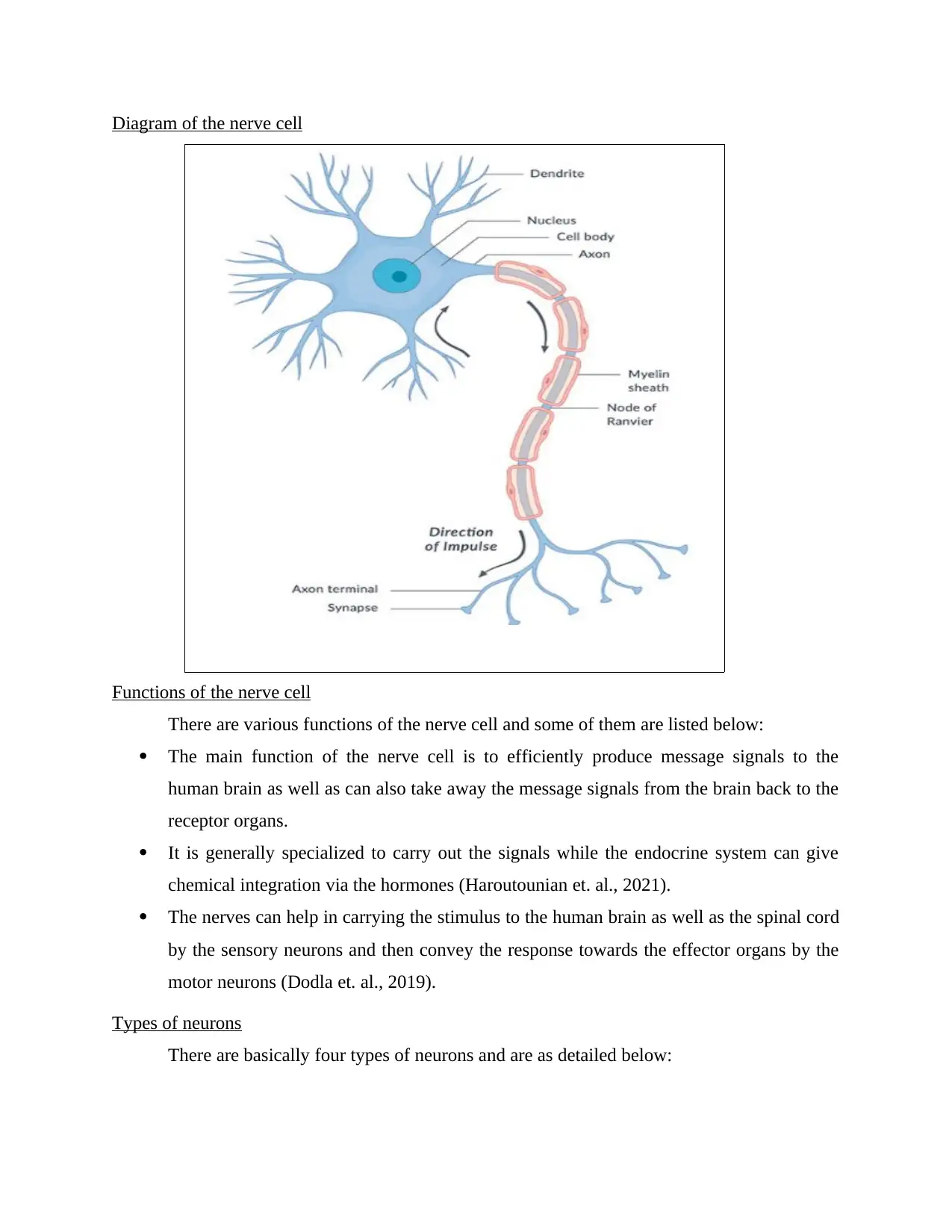
Diagram of the nerve cell
Functions of the nerve cell
There are various functions of the nerve cell and some of them are listed below:
The main function of the nerve cell is to efficiently produce message signals to the
human brain as well as can also take away the message signals from the brain back to the
receptor organs.
It is generally specialized to carry out the signals while the endocrine system can give
chemical integration via the hormones (Haroutounian et. al., 2021).
The nerves can help in carrying the stimulus to the human brain as well as the spinal cord
by the sensory neurons and then convey the response towards the effector organs by the
motor neurons (Dodla et. al., 2019).
Types of neurons
There are basically four types of neurons and are as detailed below:
Functions of the nerve cell
There are various functions of the nerve cell and some of them are listed below:
The main function of the nerve cell is to efficiently produce message signals to the
human brain as well as can also take away the message signals from the brain back to the
receptor organs.
It is generally specialized to carry out the signals while the endocrine system can give
chemical integration via the hormones (Haroutounian et. al., 2021).
The nerves can help in carrying the stimulus to the human brain as well as the spinal cord
by the sensory neurons and then convey the response towards the effector organs by the
motor neurons (Dodla et. al., 2019).
Types of neurons
There are basically four types of neurons and are as detailed below:
Paraphrase This Document
Need a fresh take? Get an instant paraphrase of this document with our AI Paraphraser
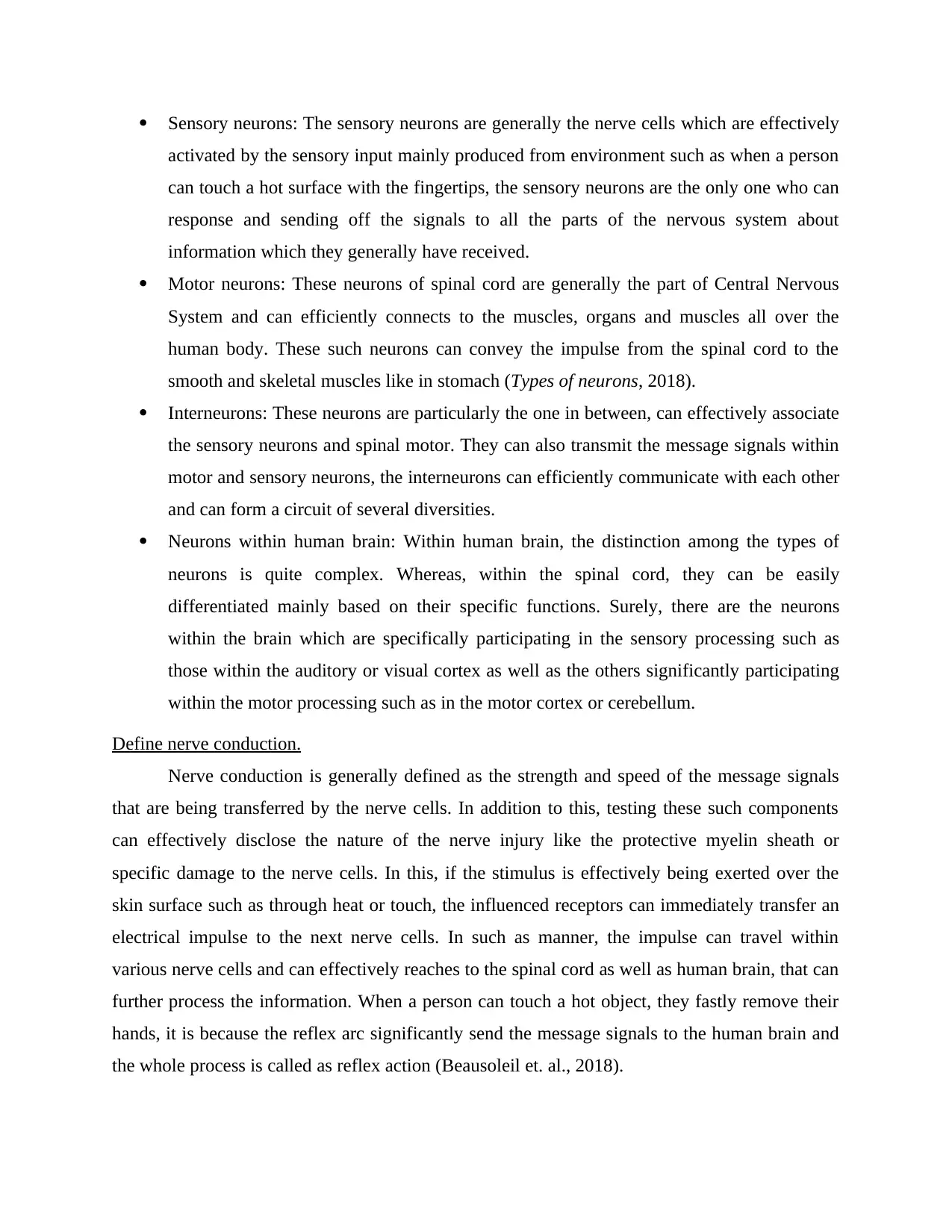
Sensory neurons: The sensory neurons are generally the nerve cells which are effectively
activated by the sensory input mainly produced from environment such as when a person
can touch a hot surface with the fingertips, the sensory neurons are the only one who can
response and sending off the signals to all the parts of the nervous system about
information which they generally have received.
Motor neurons: These neurons of spinal cord are generally the part of Central Nervous
System and can efficiently connects to the muscles, organs and muscles all over the
human body. These such neurons can convey the impulse from the spinal cord to the
smooth and skeletal muscles like in stomach (Types of neurons, 2018).
Interneurons: These neurons are particularly the one in between, can effectively associate
the sensory neurons and spinal motor. They can also transmit the message signals within
motor and sensory neurons, the interneurons can efficiently communicate with each other
and can form a circuit of several diversities.
Neurons within human brain: Within human brain, the distinction among the types of
neurons is quite complex. Whereas, within the spinal cord, they can be easily
differentiated mainly based on their specific functions. Surely, there are the neurons
within the brain which are specifically participating in the sensory processing such as
those within the auditory or visual cortex as well as the others significantly participating
within the motor processing such as in the motor cortex or cerebellum.
Define nerve conduction.
Nerve conduction is generally defined as the strength and speed of the message signals
that are being transferred by the nerve cells. In addition to this, testing these such components
can effectively disclose the nature of the nerve injury like the protective myelin sheath or
specific damage to the nerve cells. In this, if the stimulus is effectively being exerted over the
skin surface such as through heat or touch, the influenced receptors can immediately transfer an
electrical impulse to the next nerve cells. In such as manner, the impulse can travel within
various nerve cells and can effectively reaches to the spinal cord as well as human brain, that can
further process the information. When a person can touch a hot object, they fastly remove their
hands, it is because the reflex arc significantly send the message signals to the human brain and
the whole process is called as reflex action (Beausoleil et. al., 2018).
activated by the sensory input mainly produced from environment such as when a person
can touch a hot surface with the fingertips, the sensory neurons are the only one who can
response and sending off the signals to all the parts of the nervous system about
information which they generally have received.
Motor neurons: These neurons of spinal cord are generally the part of Central Nervous
System and can efficiently connects to the muscles, organs and muscles all over the
human body. These such neurons can convey the impulse from the spinal cord to the
smooth and skeletal muscles like in stomach (Types of neurons, 2018).
Interneurons: These neurons are particularly the one in between, can effectively associate
the sensory neurons and spinal motor. They can also transmit the message signals within
motor and sensory neurons, the interneurons can efficiently communicate with each other
and can form a circuit of several diversities.
Neurons within human brain: Within human brain, the distinction among the types of
neurons is quite complex. Whereas, within the spinal cord, they can be easily
differentiated mainly based on their specific functions. Surely, there are the neurons
within the brain which are specifically participating in the sensory processing such as
those within the auditory or visual cortex as well as the others significantly participating
within the motor processing such as in the motor cortex or cerebellum.
Define nerve conduction.
Nerve conduction is generally defined as the strength and speed of the message signals
that are being transferred by the nerve cells. In addition to this, testing these such components
can effectively disclose the nature of the nerve injury like the protective myelin sheath or
specific damage to the nerve cells. In this, if the stimulus is effectively being exerted over the
skin surface such as through heat or touch, the influenced receptors can immediately transfer an
electrical impulse to the next nerve cells. In such as manner, the impulse can travel within
various nerve cells and can effectively reaches to the spinal cord as well as human brain, that can
further process the information. When a person can touch a hot object, they fastly remove their
hands, it is because the reflex arc significantly send the message signals to the human brain and
the whole process is called as reflex action (Beausoleil et. al., 2018).
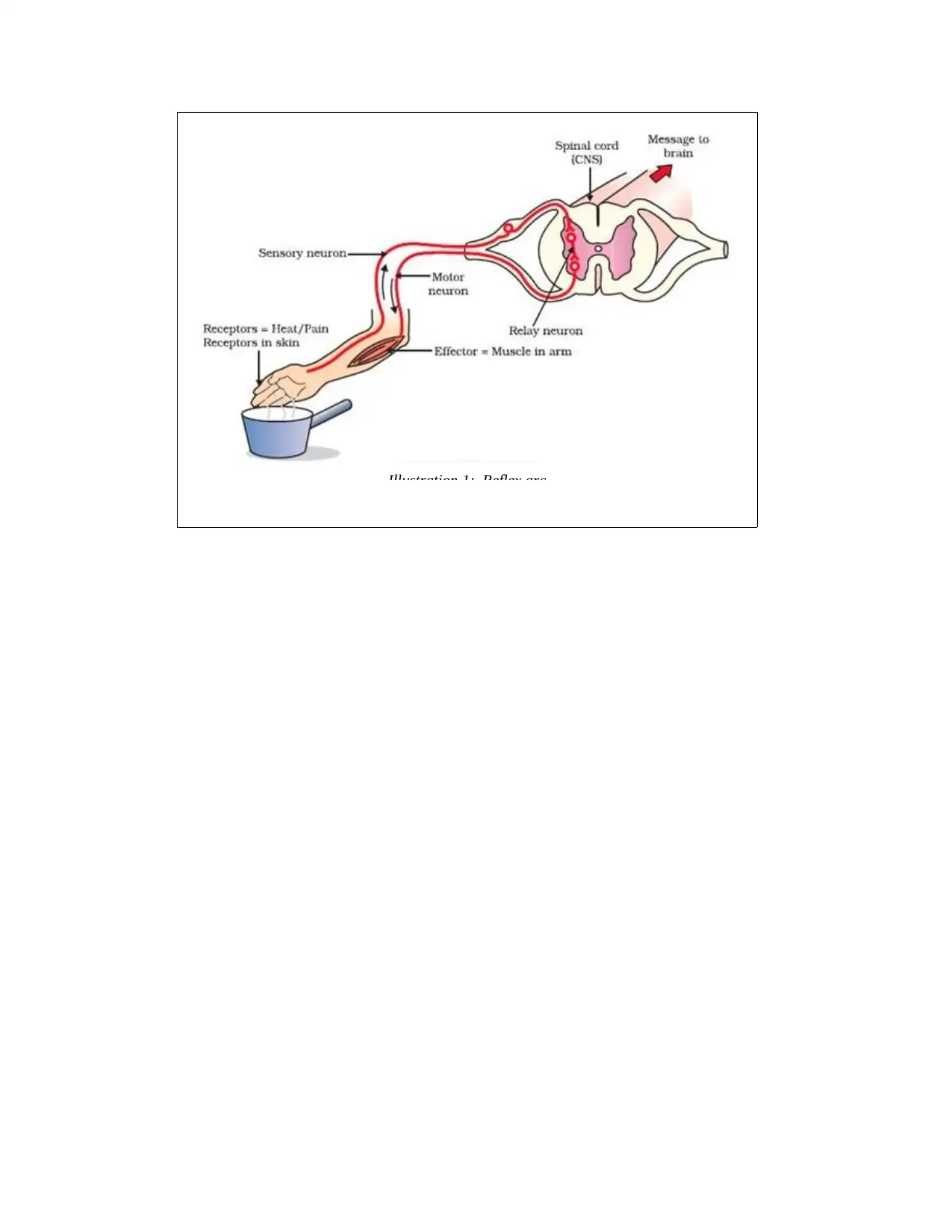
Illustration 1: Reflex arc
⊘ This is a preview!⊘
Do you want full access?
Subscribe today to unlock all pages.

Trusted by 1+ million students worldwide
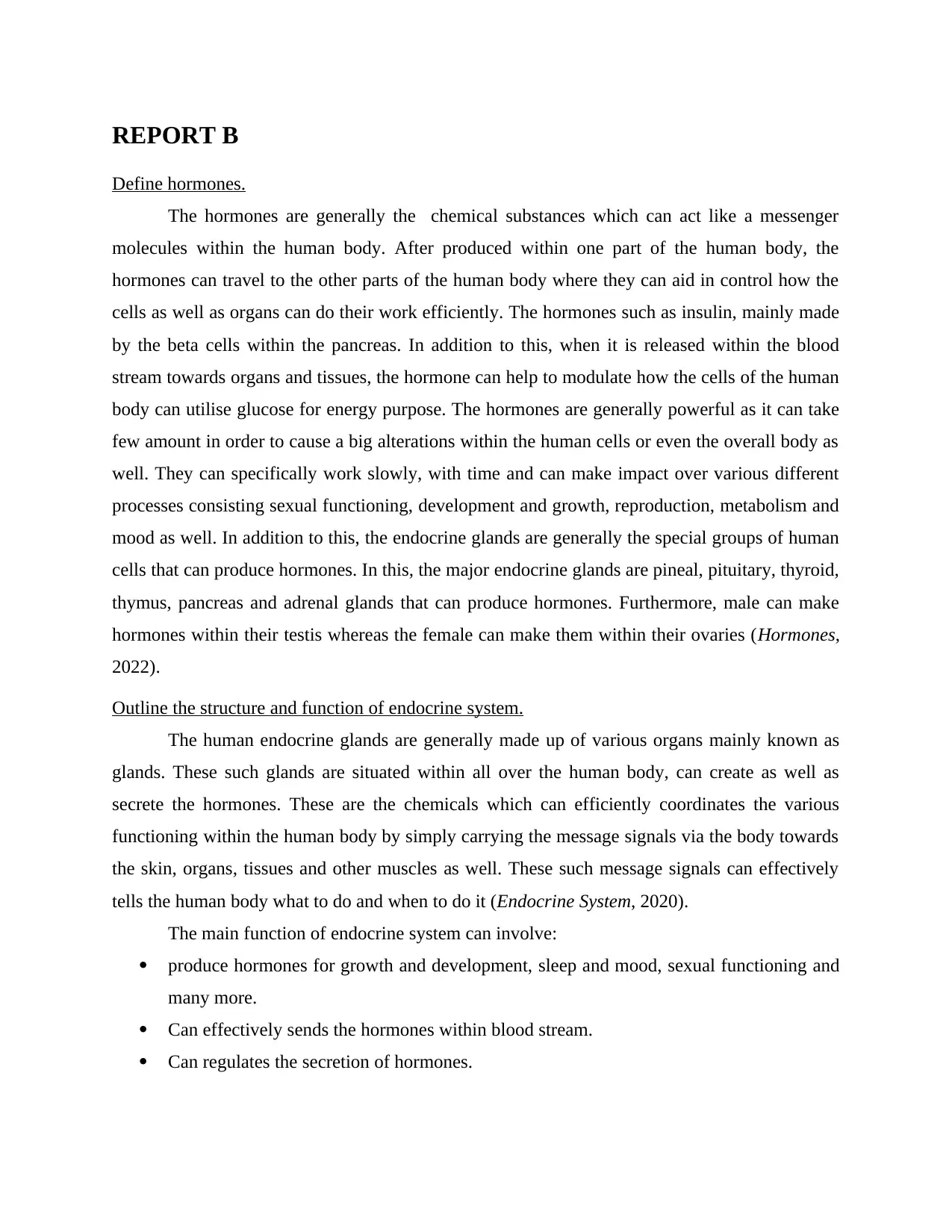
REPORT B
Define hormones.
The hormones are generally the chemical substances which can act like a messenger
molecules within the human body. After produced within one part of the human body, the
hormones can travel to the other parts of the human body where they can aid in control how the
cells as well as organs can do their work efficiently. The hormones such as insulin, mainly made
by the beta cells within the pancreas. In addition to this, when it is released within the blood
stream towards organs and tissues, the hormone can help to modulate how the cells of the human
body can utilise glucose for energy purpose. The hormones are generally powerful as it can take
few amount in order to cause a big alterations within the human cells or even the overall body as
well. They can specifically work slowly, with time and can make impact over various different
processes consisting sexual functioning, development and growth, reproduction, metabolism and
mood as well. In addition to this, the endocrine glands are generally the special groups of human
cells that can produce hormones. In this, the major endocrine glands are pineal, pituitary, thyroid,
thymus, pancreas and adrenal glands that can produce hormones. Furthermore, male can make
hormones within their testis whereas the female can make them within their ovaries (Hormones,
2022).
Outline the structure and function of endocrine system.
The human endocrine glands are generally made up of various organs mainly known as
glands. These such glands are situated within all over the human body, can create as well as
secrete the hormones. These are the chemicals which can efficiently coordinates the various
functioning within the human body by simply carrying the message signals via the body towards
the skin, organs, tissues and other muscles as well. These such message signals can effectively
tells the human body what to do and when to do it (Endocrine System, 2020).
The main function of endocrine system can involve:
produce hormones for growth and development, sleep and mood, sexual functioning and
many more.
Can effectively sends the hormones within blood stream.
Can regulates the secretion of hormones.
Define hormones.
The hormones are generally the chemical substances which can act like a messenger
molecules within the human body. After produced within one part of the human body, the
hormones can travel to the other parts of the human body where they can aid in control how the
cells as well as organs can do their work efficiently. The hormones such as insulin, mainly made
by the beta cells within the pancreas. In addition to this, when it is released within the blood
stream towards organs and tissues, the hormone can help to modulate how the cells of the human
body can utilise glucose for energy purpose. The hormones are generally powerful as it can take
few amount in order to cause a big alterations within the human cells or even the overall body as
well. They can specifically work slowly, with time and can make impact over various different
processes consisting sexual functioning, development and growth, reproduction, metabolism and
mood as well. In addition to this, the endocrine glands are generally the special groups of human
cells that can produce hormones. In this, the major endocrine glands are pineal, pituitary, thyroid,
thymus, pancreas and adrenal glands that can produce hormones. Furthermore, male can make
hormones within their testis whereas the female can make them within their ovaries (Hormones,
2022).
Outline the structure and function of endocrine system.
The human endocrine glands are generally made up of various organs mainly known as
glands. These such glands are situated within all over the human body, can create as well as
secrete the hormones. These are the chemicals which can efficiently coordinates the various
functioning within the human body by simply carrying the message signals via the body towards
the skin, organs, tissues and other muscles as well. These such message signals can effectively
tells the human body what to do and when to do it (Endocrine System, 2020).
The main function of endocrine system can involve:
produce hormones for growth and development, sleep and mood, sexual functioning and
many more.
Can effectively sends the hormones within blood stream.
Can regulates the secretion of hormones.
Paraphrase This Document
Need a fresh take? Get an instant paraphrase of this document with our AI Paraphraser
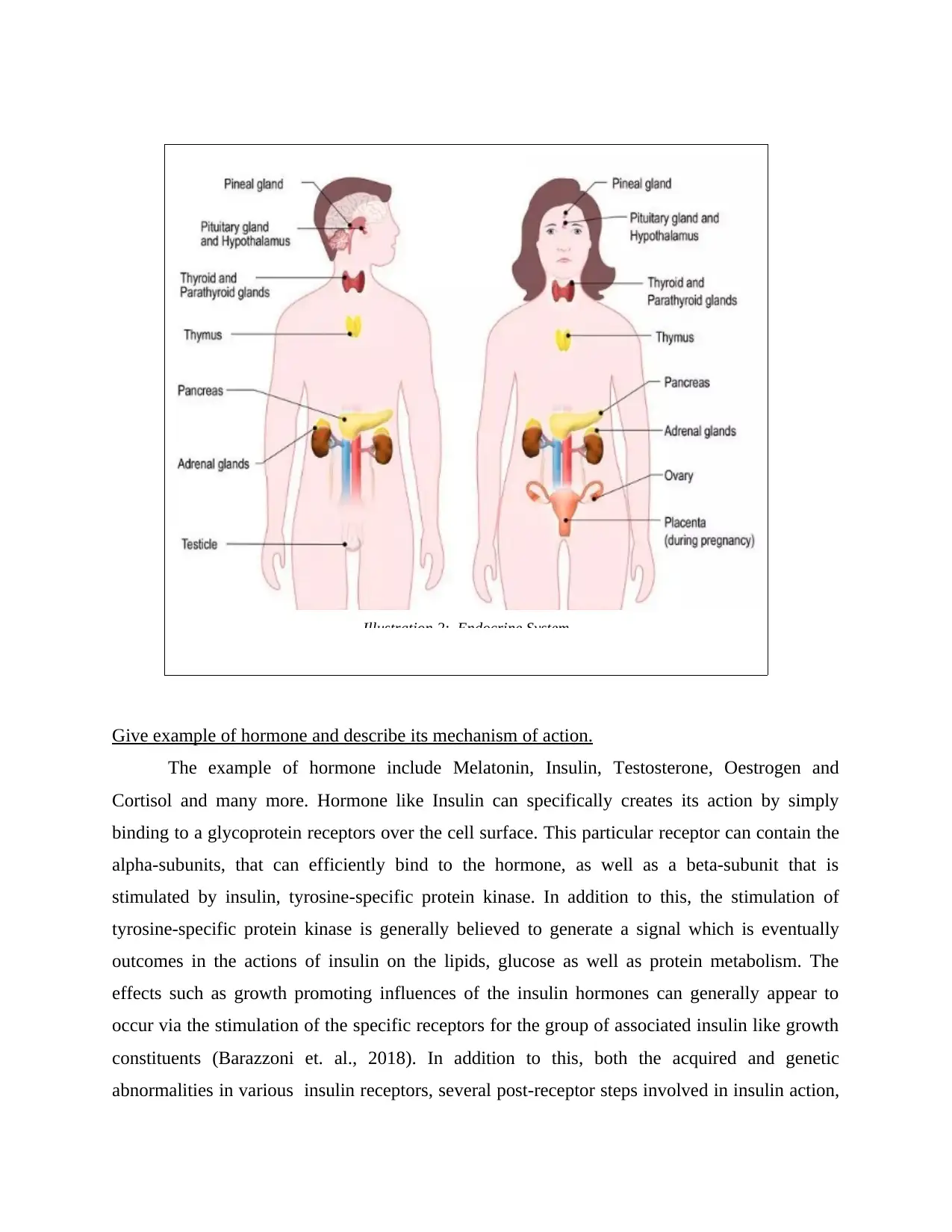
Give example of hormone and describe its mechanism of action.
The example of hormone include Melatonin, Insulin, Testosterone, Oestrogen and
Cortisol and many more. Hormone like Insulin can specifically creates its action by simply
binding to a glycoprotein receptors over the cell surface. This particular receptor can contain the
alpha-subunits, that can efficiently bind to the hormone, as well as a beta-subunit that is
stimulated by insulin, tyrosine-specific protein kinase. In addition to this, the stimulation of
tyrosine-specific protein kinase is generally believed to generate a signal which is eventually
outcomes in the actions of insulin on the lipids, glucose as well as protein metabolism. The
effects such as growth promoting influences of the insulin hormones can generally appear to
occur via the stimulation of the specific receptors for the group of associated insulin like growth
constituents (Barazzoni et. al., 2018). In addition to this, both the acquired and genetic
abnormalities in various insulin receptors, several post-receptor steps involved in insulin action,
Illustration 2: Endocrine System
The example of hormone include Melatonin, Insulin, Testosterone, Oestrogen and
Cortisol and many more. Hormone like Insulin can specifically creates its action by simply
binding to a glycoprotein receptors over the cell surface. This particular receptor can contain the
alpha-subunits, that can efficiently bind to the hormone, as well as a beta-subunit that is
stimulated by insulin, tyrosine-specific protein kinase. In addition to this, the stimulation of
tyrosine-specific protein kinase is generally believed to generate a signal which is eventually
outcomes in the actions of insulin on the lipids, glucose as well as protein metabolism. The
effects such as growth promoting influences of the insulin hormones can generally appear to
occur via the stimulation of the specific receptors for the group of associated insulin like growth
constituents (Barazzoni et. al., 2018). In addition to this, both the acquired and genetic
abnormalities in various insulin receptors, several post-receptor steps involved in insulin action,
Illustration 2: Endocrine System
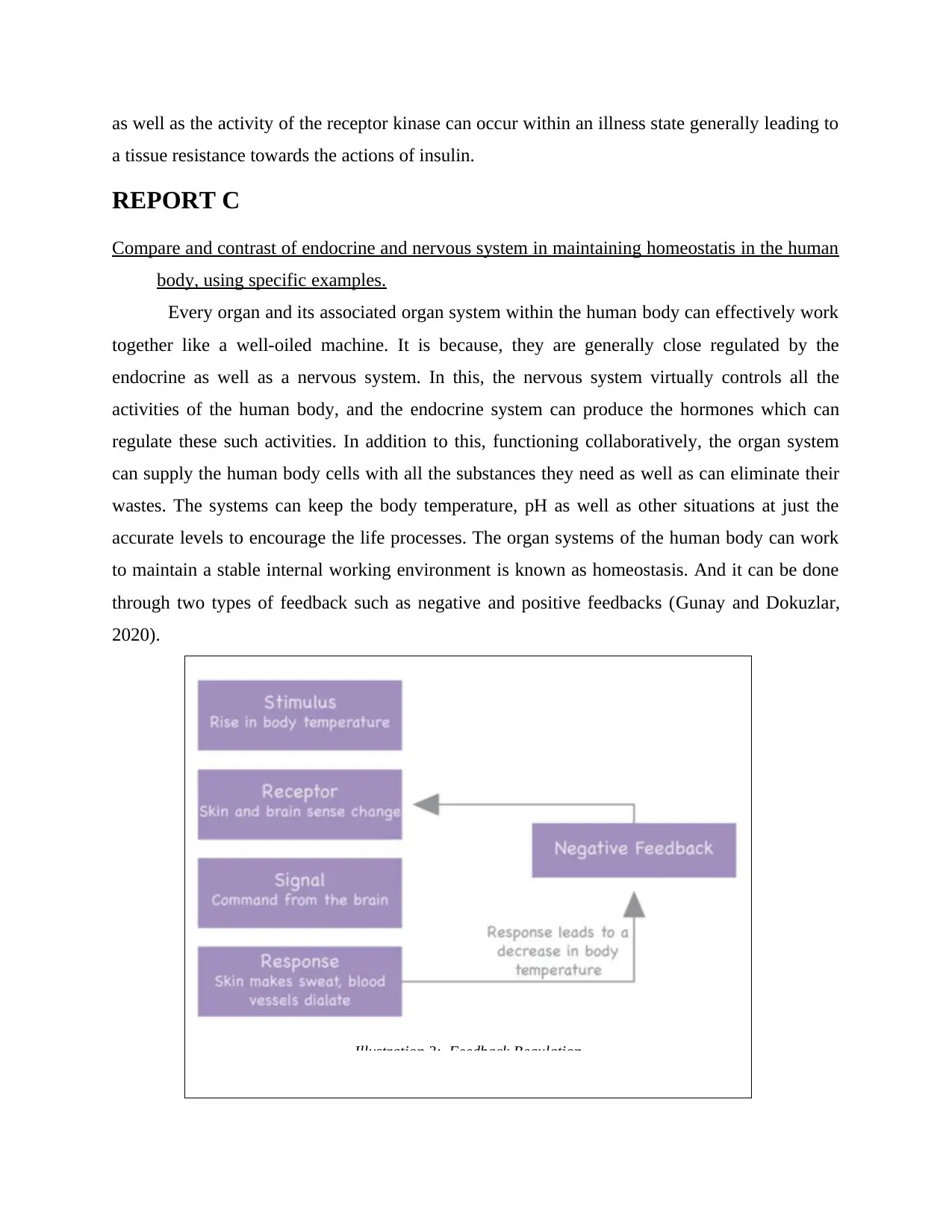
as well as the activity of the receptor kinase can occur within an illness state generally leading to
a tissue resistance towards the actions of insulin.
REPORT C
Compare and contrast of endocrine and nervous system in maintaining homeostatis in the human
body, using specific examples.
Every organ and its associated organ system within the human body can effectively work
together like a well-oiled machine. It is because, they are generally close regulated by the
endocrine as well as a nervous system. In this, the nervous system virtually controls all the
activities of the human body, and the endocrine system can produce the hormones which can
regulate these such activities. In addition to this, functioning collaboratively, the organ system
can supply the human body cells with all the substances they need as well as can eliminate their
wastes. The systems can keep the body temperature, pH as well as other situations at just the
accurate levels to encourage the life processes. The organ systems of the human body can work
to maintain a stable internal working environment is known as homeostasis. And it can be done
through two types of feedback such as negative and positive feedbacks (Gunay and Dokuzlar,
2020).
Illustration 3: Feedback Regulation
a tissue resistance towards the actions of insulin.
REPORT C
Compare and contrast of endocrine and nervous system in maintaining homeostatis in the human
body, using specific examples.
Every organ and its associated organ system within the human body can effectively work
together like a well-oiled machine. It is because, they are generally close regulated by the
endocrine as well as a nervous system. In this, the nervous system virtually controls all the
activities of the human body, and the endocrine system can produce the hormones which can
regulate these such activities. In addition to this, functioning collaboratively, the organ system
can supply the human body cells with all the substances they need as well as can eliminate their
wastes. The systems can keep the body temperature, pH as well as other situations at just the
accurate levels to encourage the life processes. The organ systems of the human body can work
to maintain a stable internal working environment is known as homeostasis. And it can be done
through two types of feedback such as negative and positive feedbacks (Gunay and Dokuzlar,
2020).
Illustration 3: Feedback Regulation
⊘ This is a preview!⊘
Do you want full access?
Subscribe today to unlock all pages.

Trusted by 1+ million students worldwide
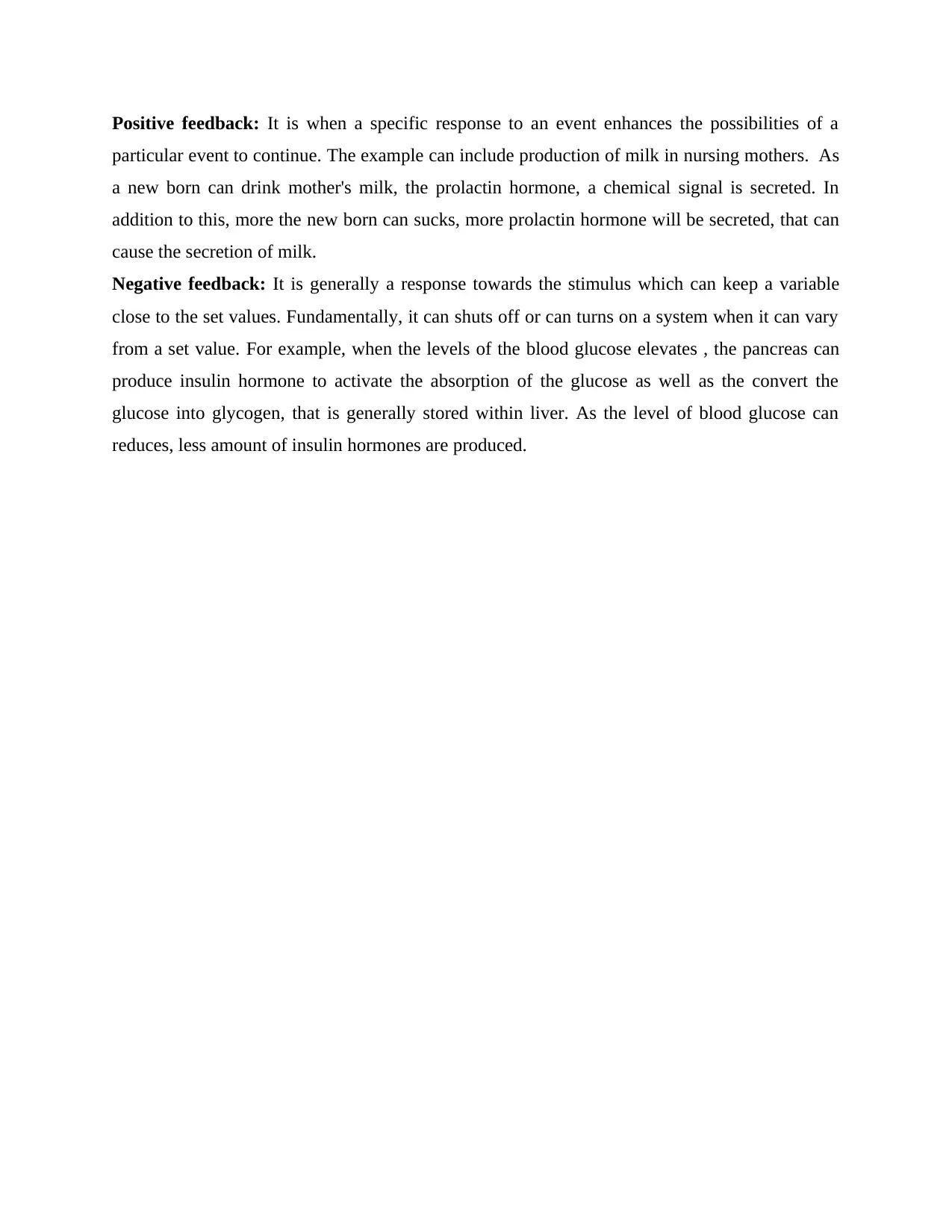
Positive feedback: It is when a specific response to an event enhances the possibilities of a
particular event to continue. The example can include production of milk in nursing mothers. As
a new born can drink mother's milk, the prolactin hormone, a chemical signal is secreted. In
addition to this, more the new born can sucks, more prolactin hormone will be secreted, that can
cause the secretion of milk.
Negative feedback: It is generally a response towards the stimulus which can keep a variable
close to the set values. Fundamentally, it can shuts off or can turns on a system when it can vary
from a set value. For example, when the levels of the blood glucose elevates , the pancreas can
produce insulin hormone to activate the absorption of the glucose as well as the convert the
glucose into glycogen, that is generally stored within liver. As the level of blood glucose can
reduces, less amount of insulin hormones are produced.
particular event to continue. The example can include production of milk in nursing mothers. As
a new born can drink mother's milk, the prolactin hormone, a chemical signal is secreted. In
addition to this, more the new born can sucks, more prolactin hormone will be secreted, that can
cause the secretion of milk.
Negative feedback: It is generally a response towards the stimulus which can keep a variable
close to the set values. Fundamentally, it can shuts off or can turns on a system when it can vary
from a set value. For example, when the levels of the blood glucose elevates , the pancreas can
produce insulin hormone to activate the absorption of the glucose as well as the convert the
glucose into glycogen, that is generally stored within liver. As the level of blood glucose can
reduces, less amount of insulin hormones are produced.
Paraphrase This Document
Need a fresh take? Get an instant paraphrase of this document with our AI Paraphraser
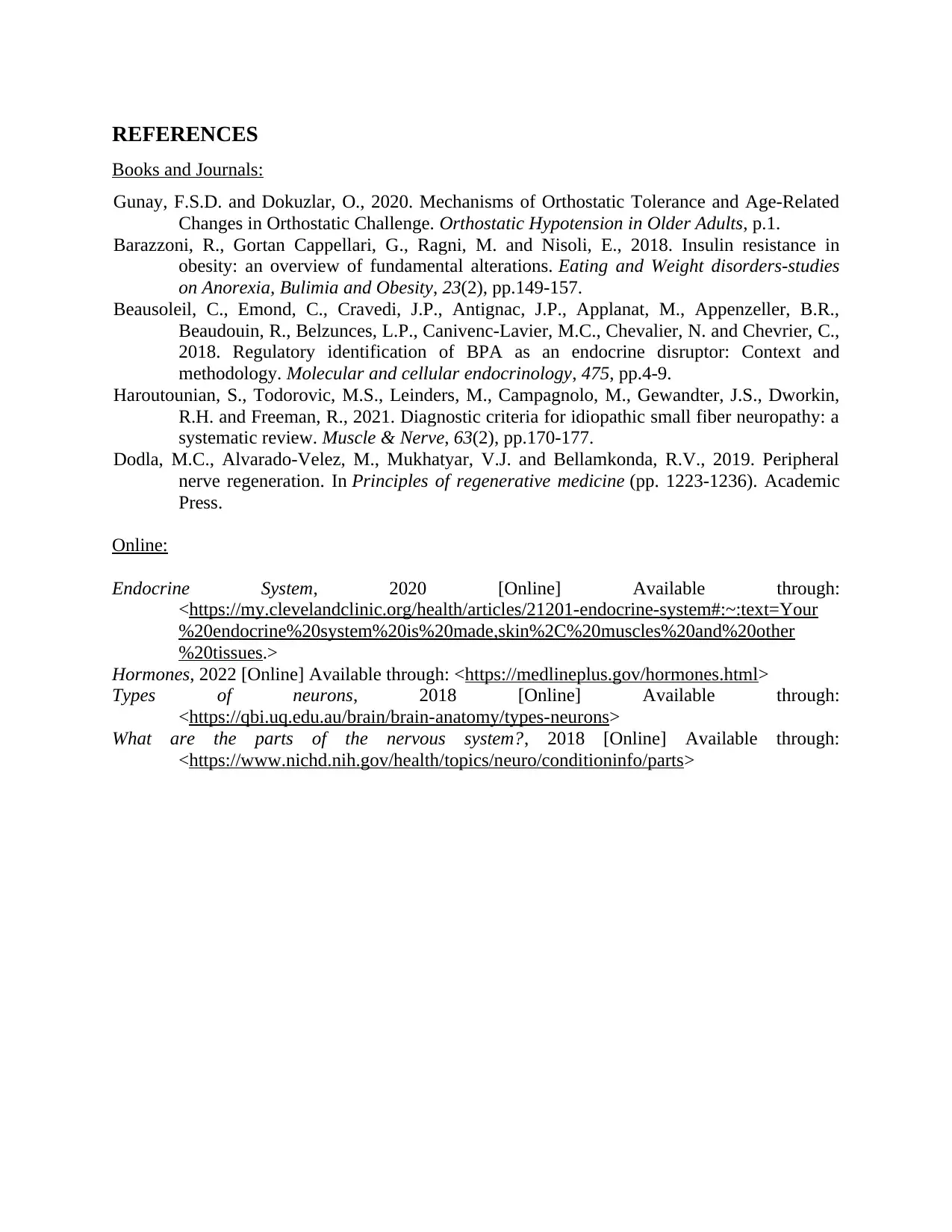
REFERENCES
Books and Journals:
Gunay, F.S.D. and Dokuzlar, O., 2020. Mechanisms of Orthostatic Tolerance and Age-Related
Changes in Orthostatic Challenge. Orthostatic Hypotension in Older Adults, p.1.
Barazzoni, R., Gortan Cappellari, G., Ragni, M. and Nisoli, E., 2018. Insulin resistance in
obesity: an overview of fundamental alterations. Eating and Weight disorders-studies
on Anorexia, Bulimia and Obesity, 23(2), pp.149-157.
Beausoleil, C., Emond, C., Cravedi, J.P., Antignac, J.P., Applanat, M., Appenzeller, B.R.,
Beaudouin, R., Belzunces, L.P., Canivenc-Lavier, M.C., Chevalier, N. and Chevrier, C.,
2018. Regulatory identification of BPA as an endocrine disruptor: Context and
methodology. Molecular and cellular endocrinology, 475, pp.4-9.
Haroutounian, S., Todorovic, M.S., Leinders, M., Campagnolo, M., Gewandter, J.S., Dworkin,
R.H. and Freeman, R., 2021. Diagnostic criteria for idiopathic small fiber neuropathy: a
systematic review. Muscle & Nerve, 63(2), pp.170-177.
Dodla, M.C., Alvarado-Velez, M., Mukhatyar, V.J. and Bellamkonda, R.V., 2019. Peripheral
nerve regeneration. In Principles of regenerative medicine (pp. 1223-1236). Academic
Press.
Online:
Endocrine System, 2020 [Online] Available through:
<https://my.clevelandclinic.org/health/articles/21201-endocrine-system#:~:text=Your
%20endocrine%20system%20is%20made,skin%2C%20muscles%20and%20other
%20tissues.>
Hormones, 2022 [Online] Available through: <https://medlineplus.gov/hormones.html>
Types of neurons, 2018 [Online] Available through:
<https://qbi.uq.edu.au/brain/brain-anatomy/types-neurons>
What are the parts of the nervous system?, 2018 [Online] Available through:
<https://www.nichd.nih.gov/health/topics/neuro/conditioninfo/parts>
Books and Journals:
Gunay, F.S.D. and Dokuzlar, O., 2020. Mechanisms of Orthostatic Tolerance and Age-Related
Changes in Orthostatic Challenge. Orthostatic Hypotension in Older Adults, p.1.
Barazzoni, R., Gortan Cappellari, G., Ragni, M. and Nisoli, E., 2018. Insulin resistance in
obesity: an overview of fundamental alterations. Eating and Weight disorders-studies
on Anorexia, Bulimia and Obesity, 23(2), pp.149-157.
Beausoleil, C., Emond, C., Cravedi, J.P., Antignac, J.P., Applanat, M., Appenzeller, B.R.,
Beaudouin, R., Belzunces, L.P., Canivenc-Lavier, M.C., Chevalier, N. and Chevrier, C.,
2018. Regulatory identification of BPA as an endocrine disruptor: Context and
methodology. Molecular and cellular endocrinology, 475, pp.4-9.
Haroutounian, S., Todorovic, M.S., Leinders, M., Campagnolo, M., Gewandter, J.S., Dworkin,
R.H. and Freeman, R., 2021. Diagnostic criteria for idiopathic small fiber neuropathy: a
systematic review. Muscle & Nerve, 63(2), pp.170-177.
Dodla, M.C., Alvarado-Velez, M., Mukhatyar, V.J. and Bellamkonda, R.V., 2019. Peripheral
nerve regeneration. In Principles of regenerative medicine (pp. 1223-1236). Academic
Press.
Online:
Endocrine System, 2020 [Online] Available through:
<https://my.clevelandclinic.org/health/articles/21201-endocrine-system#:~:text=Your
%20endocrine%20system%20is%20made,skin%2C%20muscles%20and%20other
%20tissues.>
Hormones, 2022 [Online] Available through: <https://medlineplus.gov/hormones.html>
Types of neurons, 2018 [Online] Available through:
<https://qbi.uq.edu.au/brain/brain-anatomy/types-neurons>
What are the parts of the nervous system?, 2018 [Online] Available through:
<https://www.nichd.nih.gov/health/topics/neuro/conditioninfo/parts>
1 out of 11
Related Documents
Your All-in-One AI-Powered Toolkit for Academic Success.
+13062052269
info@desklib.com
Available 24*7 on WhatsApp / Email
![[object Object]](/_next/static/media/star-bottom.7253800d.svg)
Unlock your academic potential
Copyright © 2020–2025 A2Z Services. All Rights Reserved. Developed and managed by ZUCOL.





